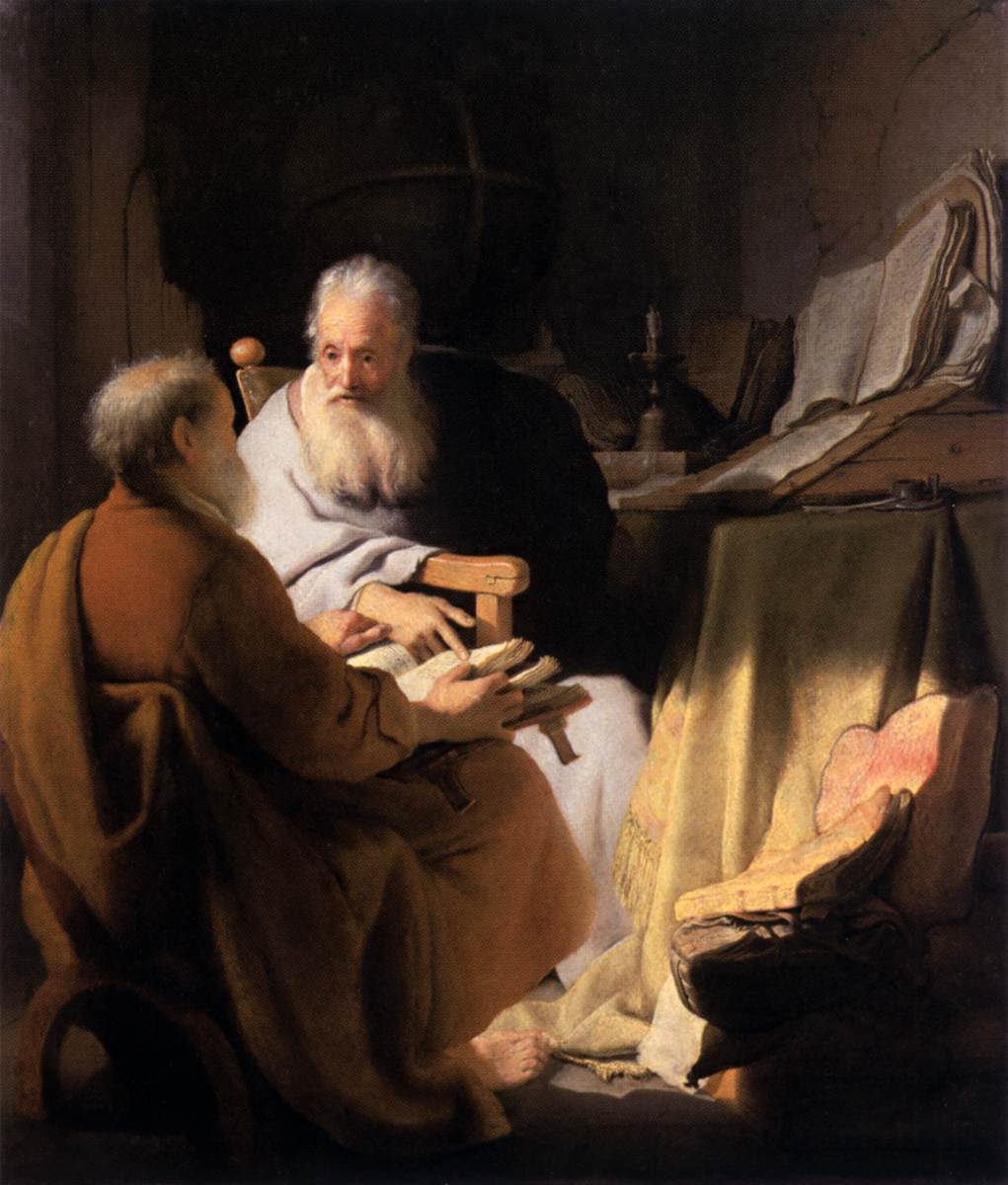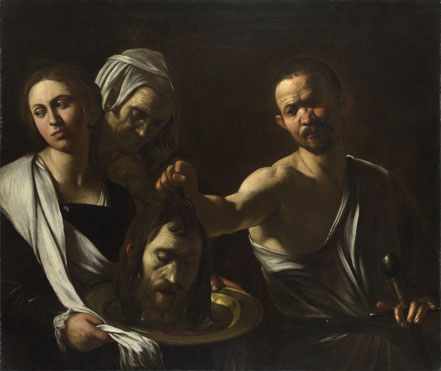* * * *

“Scholars Disputing” – a painting of Peter and Paul – yet still they managed to work together…
* * * *
 We have two major feast days coming up.
We have two major feast days coming up.
Friday, June 24, is the feast recalling the Birth of St. John, the Baptist. (He went on to “preach in the Wilderness,” as shown in the painting at right.) The following Wednesday, June 29, is the day for remembering St. Peter and St. Paul, Apostles.
And as noted in last year’s Peter, Paul – and other “relics:”
On January 18 [each year,] we celebrate the Confession of Peter: “Thou art the Christ, Son of the Living God.” A week later on January 25 we celebrate the Conversion of St. Paul. Then comes June 29, when we celebrate both men… (Emphasis added.)
But getting back to The Nativity of John the Baptist. Last year’s post noted that “John the Baptist served as a precursor, forerunner or advance man for Jesus. (As in, ‘News Flash: Jesus is on the way!‘) Or as it says in the Collect for the day: ‘Your servant John the Baptist [was] sent to prepare the way of your Son our Savior.'”
Which is pretty much what he did with his life…
See also Nativity of St. John the Baptist, from the Satucket website. (It lists the Daily Office Readings.) The article there helps explain the comment by Jesus – so puzzling to many – in Matthew 11:11: “Truly I tell you, among those born of women there has not risen anyone greater than John the Baptist; yet whoever is least in the kingdom of heaven is greater than he:”
Which sounds a lot like a backhanded compliment…
So what was the point Jesus was trying to make? One interpretation goes like this:
John represents the climax of the long tradition of Jewish prophets… John is the climax of the Law. He lives in the wilderness, a life with no frills… He has renounced the joys of family life, and dedicated himself completely [to] calling people to an observance of the law… In terms of natural goodness, no one is better than John. But he represents Law, not Grace. Among men born of woman, among the once-born, he has no superior. But anyone who has been born anew in the kingdom of God has something better than what John symbolizes.
Which brings up the controversy that’s been going on for over 2,000 years. (Since the birth of the Church.) That’s the ongoing controversy between Faith and Works. (Or between Faith and following “the Letter of the Law.”) The question is this: “Are you ‘saved’ by following a set of rules and regulations, or by faith in Jesus alone?” (See e.g., Controversy Over Faith And Works Continues.” As also noted in last year’s Peter, Paul – and other “relics.”)
Thus the argument is about how “Jesus saves.”
Does Jesus want you to earn your way into heaven? Or do you get there simply by accepting His free gift? (Or put another way, the issue is one of “legalism” versus “grace.”)
 In this debate, John represented the Old Way. (Resulting in the kind of “ending” illustrated at left.) Jesus – on the other hand – represents the New Way. “John is the climax of the Law… But anyone who has been born anew in the kingdom of God has something better than what John symbolizes.” That would be grace, which “excludes merit.”
In this debate, John represented the Old Way. (Resulting in the kind of “ending” illustrated at left.) Jesus – on the other hand – represents the New Way. “John is the climax of the Law… But anyone who has been born anew in the kingdom of God has something better than what John symbolizes.” That would be grace, which “excludes merit.”
Which is another way of saying that practicing Christians should not go around being obnoxious, as Paul noted in 1st Corinthians 4:7:
Who says that you are any better than other people? What do you have that wasn’t given to you [by God]? If you were given what you have, why are you bragging as if it weren’t a gift?
Of course many say, “I earned everything I have, through the sweat of my brow.” Which raises the questions: “Who gave you the brow? And who gave you the capacity to sweat?” Which is another way of saying the myth that you can earn your way into heaven dies hard.
But we digress… Getting back to the feast for the Birth of John the Baptist: The Bible readings for the day are Isaiah 40:1-11, Psalm 85, Acts 13:14b-26, and Luke 1:57-80.
 Turning to the Feast for June 29: Last year’s Peter, Paul – and other “relics” noted that that particular date was chosen as “the anniversary either of their death or of the translation of their relics:”
Turning to the Feast for June 29: Last year’s Peter, Paul – and other “relics” noted that that particular date was chosen as “the anniversary either of their death or of the translation of their relics:”
On 29 June we commemorate the martyrdoms of both apostles. The date is the anniversary of a day around 258, under the Valerian Persecution, when what were believed to be the remains of the two apostles were both moved temporarily to prevent them from falling into the hands of the persecutors.
Thus the term relic – as used here – means the body parts of people considered especially holy. (Like Peter and Paul.) In turn translating relics means moving those “holy objects from one locality to another.” (Usually to a “better neighborhood,” metaphorically. For example, the image above right shows “St. Corbinian’s relics being moved to Freising from Merano.”)
Last year’s post indicated the dispute between Peter and Paul came to a head with the Incident at Antioch. As to that dispute the Wikipedia article added, “The final outcome of the incident remains uncertain resulting in several Christian views of the Old Covenant to this day.”
(Briefly, that question involves how much of the Old Testament “law” is binding on Christians.)
However, to me the main point of the Feast of Peter and Paul was that it’s okay to have differences of opinion between Christians. (Or even to “squabble” from time to time. And for that matter, that it’s okay to argue with God too, if and as necessary…)
In the meantime, enjoy the painting below, of Jesus and John, together as youngsters…
* * * *
John the Baptist – at right – and the boy Jesus, enjoying their childhood…
* * * *
The upper image is courtesy of Two Scholars Disputing by REMBRANDT Harmenszoon … (web gallery of art.) The explanatory section added that the most likely explanation of the painting is that it “represents St Peter and St Paul in conversation,” or even Argument:
Rembrandt omits the attributes by which the two apostles were traditionally identified, he relies only on their physical characteristics … and on what they are seen to be doing, that is earnestly discussing a text which the one (St Peter) is explaining to the other.
For other interpretations and/or images, see also www.canvasreplicas.com/Rembrandt.htm. See also Two Scholars Disputing by REMBRANDT Harmenszoon van Rijn.
Re: The Controversy Over Faith And Works. See also the Matthew Henry Commentary on Matthew 11:11: “The things of God are of great and common concern. God requires no more from us than the right use of the faculties he has given us.”
Re: John as “climax of the Law.” See In the Bible we read about “the law”. What does this mean?
As God’s new creation we actually want to obey His law – not because it gets us anything, but because of our love for Him. We still say with the Psalmist in his ageless words, “I desire to do your will, O my God; your law is within my heart.” (Psalm 40:8)
Emphasis added. Which is yet another way of saying that even Christian of long-standing need to remind themselves that “the myth that you can earn your way into heaven dies hard.”
The “Jesus is Lord” image is courtesy of How Faith Works | Christianity Today. That article studied the issue in-depth, including a note on the “progressive character” of the Christian spiritual journey. It said that “under the influence of the Word and the Spirit … believers begin to grow in holiness.”
Re: the “sweat of my brow,” The term also refers to an “intellectual property law doctrine, chiefly related to copyright law.” See Sweat of the brow – Wikipedia.
Re: The image to the left of the paragraph, “Briefly, John represented the Old Way.” Titled “Salome receives the Head of John the Baptist,” it is courtesy of nationalgallery.org.uk/paintings/caravaggio:
The subject is from the New Testament [Mark 6, verses 14-29]. Salome had danced so well for King Herod that he swore he would grant her any request. Her mother, Herodias, who sought revenge on John the Baptist, persuaded Salome to ask for his head. The old woman behind Salome may be Herodias.”
The lower image is courtesy of John the Baptist – Wikipedia, the free encyclopedia. The caption: “John the Baptist (right) with child Jesus, painting by Bartolomé Esteban Perez Murillo.”
Re: John and Jesus enjoying their childhood. See also Childhood – Wikipedia, which noted:
Nature deficit disorder, a term coined by Richard Louv in his 2005 book Last Child in the Woods, refers to the trend in the United States and Canada towards less time for outdoor play resulting in a wide range of behavioral problems. With the heavy use of cellphones, computers, video games and television, children have more reasons to stay inside rather than outdoors exploring… The media has accelerated the trend by de-emphasizing views of nature, as in Disney films.
See also Food for thought, i.e.: “something that warrants serious consideration.”
* * * *